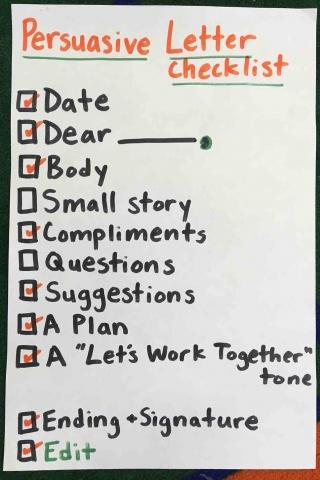Since I was a small child, I have found great joy in writing and receiving handwritten letters. To help my students grow as writers and community members, I teach the art of letter writing to my 2nd-graders.
A letter allows the writer to focus on communicating with a specific audience in mind. A letter can often be completed in one writing period and can be used to emphasize clarity and legibility.
At the beginning of each school year, I teach students the parts of a letter. We sing, “Date, greeting and the body (make it friendly)” to the tune of “Head, shoulders, knees and toes.” We practice by writing friendly letters, including thank-you notes to our field trip chaperones.
When we move on to persuasive writing, I often read “Thank You, Sarah,” by Laurie Halse Anderson, to my students. The book tells the true story of Sarah Hale, whose letter persuaded President Abraham Lincoln to declare Thanksgiving a national holiday. Writers’ block seems to dissolve as students brainstorm the topic of their persuasive letters, from getting a pet at home to requesting a longer recess at school. My students have received replies to their persuasive letters from authors, politicians, toy companies and principals.
One of my favorite letter-writing traditions is a “Dear Teacher” letter, which students write each month in their writing notebooks starting in September. I ask students to write this letter directly to me, and I assure them that it will be part of a private conversation. I encourage them to write to me about things they are enjoying in school, things they are learning, challenges and questions they may have, things they are looking forward to and anything they think may be important for me to know about their lives outside the classroom.
Their September letters are usually somewhat tentative, but the students look forward to receiving the replies that I jot in their notebooks. The following month, the students continue the conversation in the same section of their notebooks. With each passing month, they have more to say, and I hear their authentic voices emerge. The students often feel more comfortable holding this conversation in a letter rather than face to face. The students find it gratifying to look over previous letters as a record of their own thoughts, as well as to see how their spelling and handwriting have developed.
In teaching letter writing, we consciously create a community that values authentic communication. In a fast-paced world where tweets, texts and posts are shared so quickly, it is a sweet luxury to take the time to put pen to paper and write down what is in one’s mind and heart.
Recently, a student asked me in her monthly letter, “What are you happy about?” I loved the beauty and innocence of her question. As I sat, considering my truest response, I realized that the act of reading her letter, and those of her classmates, made me happy.
